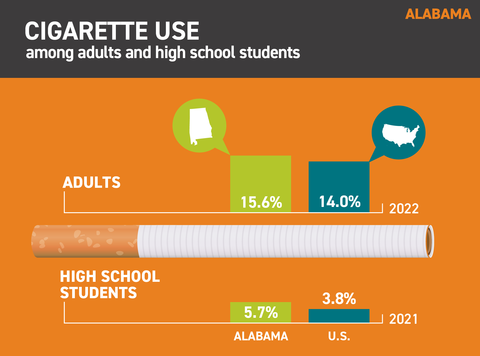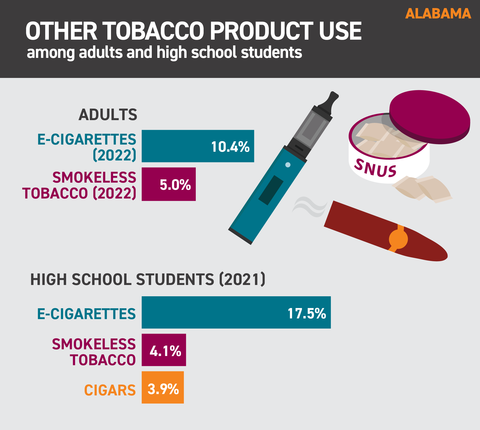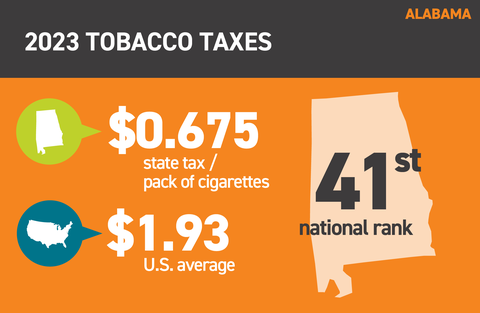Tobacco use in Alabama 2023
Cigarette use: Alabama*
Smoking rate in Alabama
- In 2022, 15.6% of adults smoked. Nationally, adult smoking prevalence was 14.0% 1
- In 2021, 5.7% of high school students in Alabama smoked cigarettes on at least one day in the past 30 days. Nationally, youth smoking prevalence was 3.8%.2
Other tobacco product use: Alabama*
Vaping rate in Alabama
- In 2022, 10.4% of adults in Alabama used e-cigarettes. Nationally, adult e-cigarette use prevalence was 7.7%.1
- In 2022, 5.0% of adults in Alabama used smokeless tobacco every day or some days. Nationally, adult smokeless tobacco use prevalence was 3.4%.1
- In 2021, 17.5% of high school students in Alabama used electronic vapor products on at least one day in the past 30 days. Nationally, e-cigarette use prevalence among high school students was 18.0%.2
- In 2021, 4.1% of high school students in Alabama used chewing tobacco, snuff or dip on at least one day in the past 30 days. Nationally, the smokeless tobacco use prevalence among high school students was 2.5%. 2
- In 2021, 3.9% of high school students in Alabama smoked cigars, cigarillos or little cigars on at least one day in the past 30 days. Nationally, cigar use prevalence among high school students was 3.1%.2
Economics of tobacco use and tobacco control
Tobacco taxes in Alabama
- Alabama received $288.3 million (estimated) in revenue from tobacco settlement payments and taxes in fiscal year 2023.4
- Of this, the state allocated $1.7 million in state funds to tobacco prevention in fiscal year 2023, just 3.1% of the Centers for Disease Control and Prevention’s annual spending target.4
- Smoking-related health care costs: $2.19 billion per year.4
- Smoking-related losses in productivity: $5.6 billion per year.5
Alabama tobacco laws
Alabama tobacco laws
Tobacco taxes
- Alabama is ranked 41st in the U.S. for its cigarette tax of 67.5 cents per pack (enacted October 2015), compared with the national average of $1.93. (New York has the highest tax at $5.35 and Missouri has the lowest at 17 cents.) 6-8
- Chewing tobacco is taxed at 1.5 cents per ounce. Little cigars and filtered cigars (not weighing more than 3 pounds/thousand) are taxed at 4 cents per each 10 cigars. Filtered cigars (weighing more than 3 pounds/thousand) are taxed at 1.5 cents per cigar. All other cheroots, stogies, and cigars are taxed at 4.05 cents per cigar. All other tobacco products have varying taxes based on weight and price.6,7
Clean indoor air ordinances
- Smoking is restricted in all government workplaces, schools, childcare facilities, retail stores and recreational/cultural facilities.7
- Smoking restrictions are not required in private workplaces, restaurants, bars or casinos/gaming establishments.7
- The use of e-cigarettes is prohibited at licensed day care facilities and “vehicles used to transport children” and licensed emergency medical providers cannot use e-cigarettes while operating or riding in an ambulance or while providing patient care.9
Licensing laws
- Retailers and wholesalers are required to obtain a license to sell tobacco products.6
- A retail license is required to sell e-cigarette products. A county may not issue a license for sales of e-cigarettes if the retail business is located within 1,000 feet of a school, child-care facility, church, public library, playground or park, or other youth-centered facility or space after January 1, 2020 (unless the retailer is a specialty shop that has been in business at that location for 18 consecutive months).9
Youth access laws
- In December 2019, the United States adopted a law raising the federal minimum age of sale of all tobacco products to 21, effective immediately.
- Establishments are required to post signs stating that sales to minors are prohibited.6
- Minors are prohibited from buying electronic smoking devices, including e-cigarettes.6
- Advertising electronic nicotine delivery systems on a billboard as available in flavors other than tobacco, mint or menthol within 1,000 feet of any school or public playground is prohibited. Additionally, electronic nicotine delivery systems may not be advertised or marketed using terms like “candy” or other sweet or dessert-like descriptors, or any other imagery that is known to appeal to minors.9
Quitting statistics and benefits
Quitting smoking in Alabama
- The CDC estimates 54.1% of daily adult smokers in Alabama quit smoking for one or more days in 2019.3
- In 2014, the Affordable Care Act required that Medicaid programs cover all quit medications.7**
- Alabama’s state quit line invests $1.66 per smoker, compared with the national median of $2.37.7
- Alabama does not have a private insurance mandate provision for quitting tobacco.7
Notes and references
Notes and references
Updated June 2023
*The datasets for both adults and youth prevalence were used to make direct comparisons at the state and national levels. National prevalence reported here may differ from what is reported in our national-level fact sheets. The numbers here also reflect the most recent data available. Dates of available data may differ across state fact sheets.
**The seven recommended quitting medications are NRT gum, NRT patch, NRT nasal spray, NRT inhaler, NRT lozenge, Varenicline (Chantix) and Bupropion (Zyban).
Fiore MC, et al. Treating Tobacco Use and Dependence: 2008 Update. Clinical Practice Guideline. Rockville, MD: US Department of Health and Human Services. Public Health Service: May 2008.
1. CDC, Behavioral Risk Factor Surveillance System, 2023.
2. CDC, Youth Risk Behavioral Surveillance System, 2021.
3. CDC, Behavioral Risk Factor Surveillance System, State Tobacco Activities Tracking and Evaluation System, 2023.
4. Campaign for Tobacco-Free Kids, Broken Promises to Our Children: a State-by-State Look at the 1998 State Tobacco Settlement 24 Years Later FY2023, 2023.
5. Campaign for Tobacco-Free Kids, Toll of Tobacco in the United States.
6. American Lung Association, State Legislated Actions on Tobacco Issues (SLATI).
7. American Lung Association, State of Tobacco Control, 2023.
8. Campaign for Tobacco-Free Kids. State Cigarette Excise Tax Rates & Rankings. https://www.tobaccofreekids.org/assets/factsheets/0097.pdf. Accessed October 4th, 2023.
9. Public Health Law Center. U.S. E-Cigarette Regulation: 50-State Review. http://www.publichealthlawcenter.org/resources/us-e-cigarette-regulations-50-state-review. Accessed October 4th, 2023.





